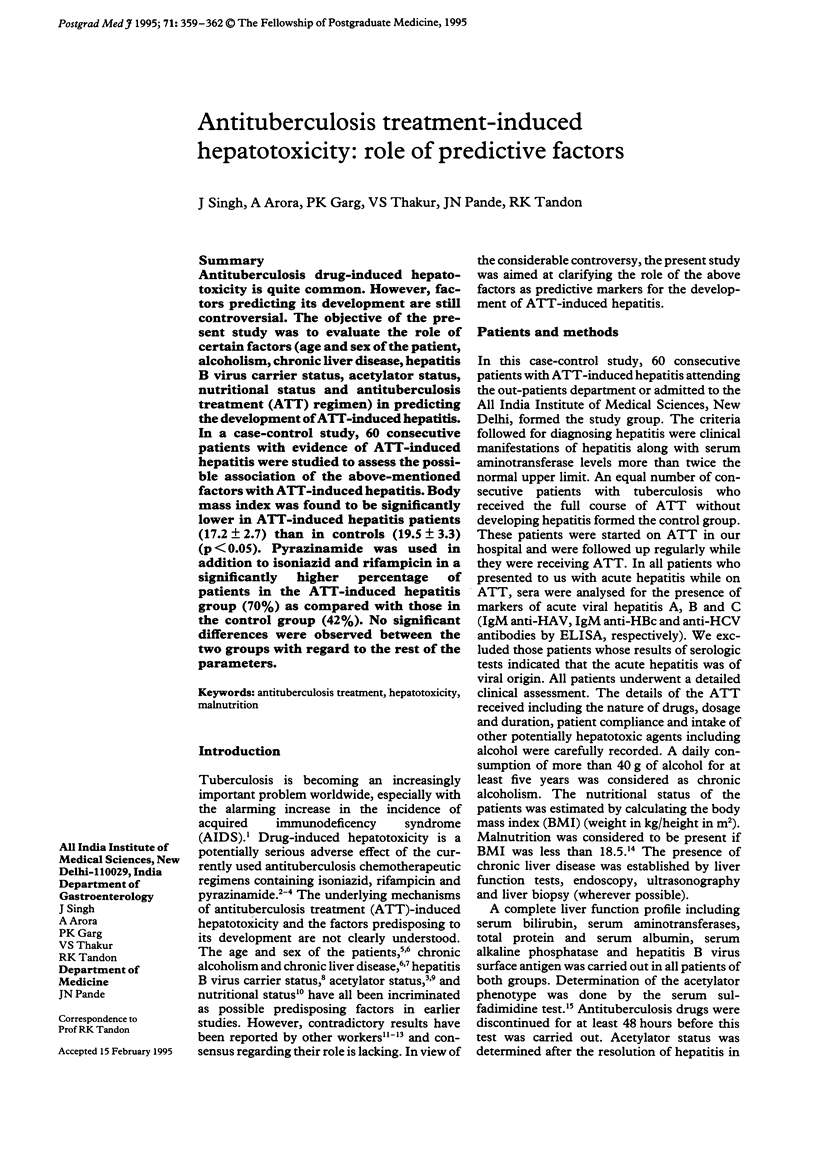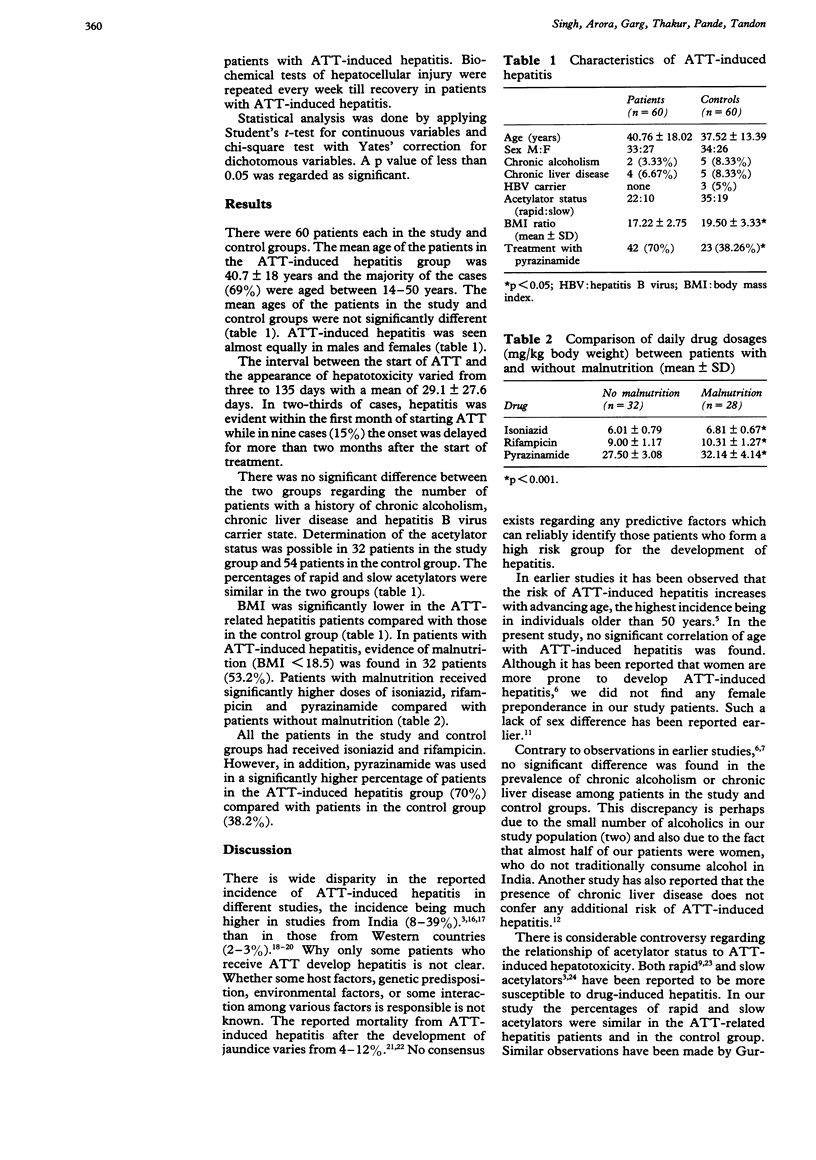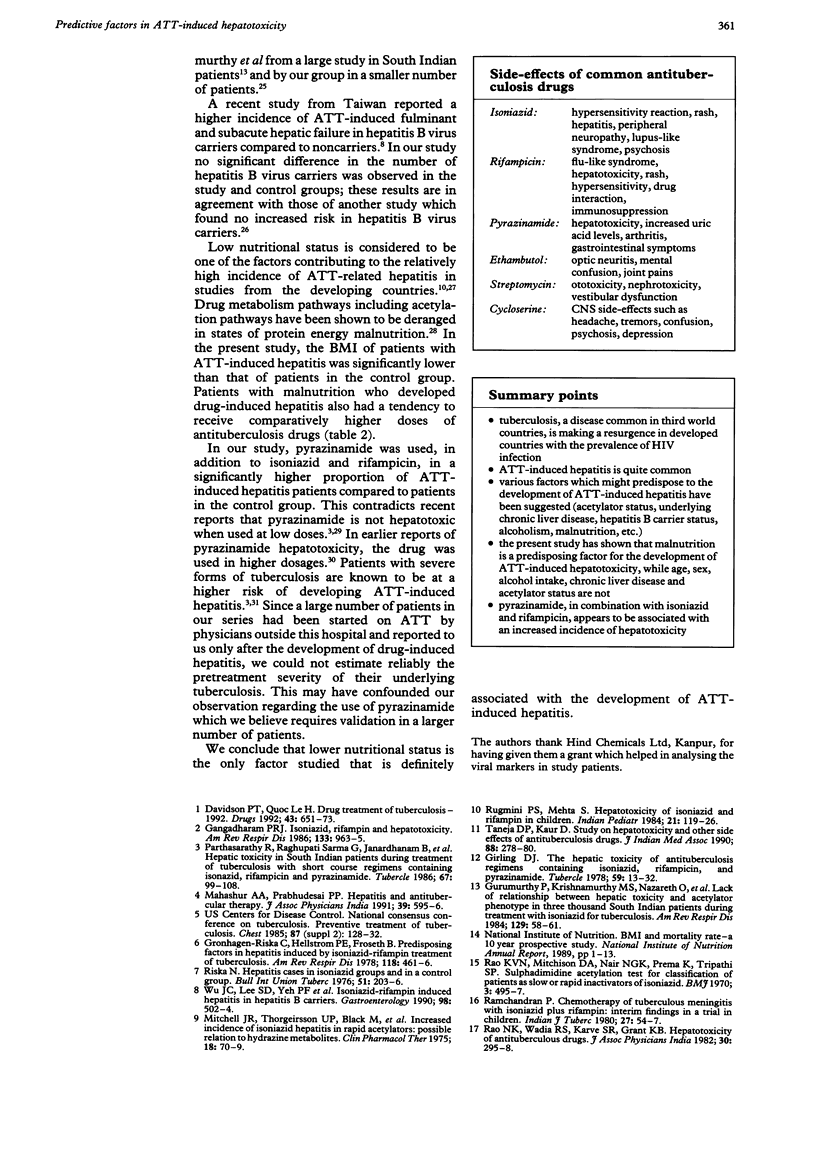Abstract
Antituberculosis drug-induced hepatotoxicity is quite common. However, factors predicting its development are still controversial. The objective of the present study was to evaluate the role of certain factors (age and sex of the patient, alcoholism, chronic liver disease, hepatitis B virus carrier status, acetylator status, nutritional status and antituberculosis treatment (ATT) regimen) in predicting the development of ATT-induced hepatitis. In a case-control study, 60 consecutive patients with evidence of ATT-induced hepatitis were studied to assess the possible association of the above-mentioned factors with ATT-induced hepatitis. Body mass index was found to be significantly lower in ATT-induced hepatitis patients (17.2 +/- 2.7) than in controls (19.5 +/- 3.3) (p < 0.05). Pyrazinamide was used in addition to isoniazid and rifampicin in a significantly higher percentage of patients in the ATT-induced hepatitis group (70%) as compared with those in the control group (42%). No significant differences were observed between the two groups with regard to the rest of the parameters.
Full text
PDF



Selected References
These references are in PubMed. This may not be the complete list of references from this article.
- Ansari M. M., Beg M. H., Haleem S. Hepatitis in patients with surgical complications of pulmonary tuberculosis. Indian J Chest Dis Allied Sci. 1991 Jul-Sep;33(3):133–138. [PubMed] [Google Scholar]
- Black M., Mitchell J. R., Zimmerman H. J., Ishak K. G., Epler G. R. Isoniazid-associated hepatitis in 114 patients. Gastroenterology. 1975 Aug;69(2):289–302. [PubMed] [Google Scholar]
- Buchanan N., Eyberg C., Davis M. D. Isoniazid pharmacokinetics in kwashiorkor. S Afr Med J. 1979 Aug 25;56(8):299–300. [PubMed] [Google Scholar]
- Davidson P. T., Le H. Q. Drug treatment of tuberculosis--1992. Drugs. 1992 May;43(5):651–673. doi: 10.2165/00003495-199243050-00003. [DOI] [PubMed] [Google Scholar]
- Dutt A. K., Moers D., Stead W. W. Short-course chemotherapy for tuberculosis with mainly twice-weekly isoniazid and rifampin. Community physicians' seven-year experience with mainly outpatients. Am J Med. 1984 Aug;77(2):233–242. doi: 10.1016/0002-9343(84)90697-1. [DOI] [PubMed] [Google Scholar]
- Gangadharam P. R. Isoniazid, rifampin, and hepatotoxicity. Am Rev Respir Dis. 1986 Jun;133(6):963–965. doi: 10.1164/arrd.1986.133.6.963. [DOI] [PubMed] [Google Scholar]
- Girling D. J. The hepatic toxicity of antituberculosis regimens containing isoniazid, rifampicin and pyrazinamide. Tubercle. 1978 Mar;59(1):13–32. doi: 10.1016/0041-3879(77)90022-8. [DOI] [PubMed] [Google Scholar]
- Grönhagen-Riska C., Hellstrom P. E., Fröseth B. Predisposing factors in hepatitis induced by isoniazid-rifampin treatment of tuberculosis. Am Rev Respir Dis. 1978 Sep;118(3):461–466. doi: 10.1164/arrd.1978.118.3.461. [DOI] [PubMed] [Google Scholar]
- Gurumurthy P., Krishnamurthy M. S., Nazareth O., Parthasarathy R., Sarma G. R., Somasundaram P. R., Tripathy S. P., Ellard G. A. Lack of relationship between hepatic toxicity and acetylator phenotype in three thousand South Indian patients during treatment with isoniazid for tuberculosis. Am Rev Respir Dis. 1984 Jan;129(1):58–61. doi: 10.1164/arrd.1984.129.1.58. [DOI] [PubMed] [Google Scholar]
- Kopanoff D. E., Snider D. E., Jr, Caras G. J. Isoniazid-related hepatitis: a U.S. Public Health Service cooperative surveillance study. Am Rev Respir Dis. 1978 Jun;117(6):991–1001. doi: 10.1164/arrd.1978.117.6.991. [DOI] [PubMed] [Google Scholar]
- Kumar A., Misra P. K., Mehotra R., Govil Y. C., Rana G. S. Hepatotoxicity of rifampin and isoniazid. Is it all drug-induced hepatitis? Am Rev Respir Dis. 1991 Jun;143(6):1350–1352. doi: 10.1164/ajrccm/143.6.1350. [DOI] [PubMed] [Google Scholar]
- Lal S., Singhal S. N., Burley D. M., Crossley G. Effect of rifampicin and isoniazid on liver function. Br Med J. 1972 Jan 15;1(5793):148–150. doi: 10.1136/bmj.1.5793.148. [DOI] [PMC free article] [PubMed] [Google Scholar]
- MACLEOD H. M., HAY D., STEWART S. M. The use of pyrazinamide plus isoniazid in the treatment of pulmonary tuberculosis. Tubercle. 1959 Feb;40(1):14–20. doi: 10.1016/s0041-3879(59)80015-5. [DOI] [PubMed] [Google Scholar]
- Mahashur A. A., Prabhudesai P. P. Hepatitis and antitubercular therapy. J Assoc Physicians India. 1991 Aug;39(8):595–596. [PubMed] [Google Scholar]
- McGlynn K. A., Lustbader E. D., Sharrar R. G., Murphy E. C., London W. T. Isoniazid prophylaxis in hepatitis B carriers. Am Rev Respir Dis. 1986 Oct;134(4):666–668. doi: 10.1164/arrd.1986.134.4.666. [DOI] [PubMed] [Google Scholar]
- Mitchell J. R., Thorgeirsson U. P., Black M., Timbrell J. A., Snodgrass W. R., Potter W. Z., Jollow H. R., Keiser H. R. Increased incidence of isoniazid hepatitis in rapid acetylators: possible relation to hydranize metabolites. Clin Pharmacol Ther. 1975 Jul;18(1):70–79. doi: 10.1002/cpt197518170. [DOI] [PubMed] [Google Scholar]
- O'Brien R. J., Long M. W., Cross F. S., Lyle M. A., Snider D. E., Jr Hepatotoxicity from isoniazid and rifampin among children treated for tuberculosis. Pediatrics. 1983 Oct;72(4):491–499. [PubMed] [Google Scholar]
- Parthasarathy R., Sarma G. R., Janardhanam B., Ramachandran P., Santha T., Sivasubramanian S., Somasundaram P. R., Tripathy S. P. Hepatic toxicity in South Indian patients during treatment of tuberculosis with short-course regimens containing isoniazid, rifampicin and pyrazinamide. Tubercle. 1986 Jun;67(2):99–108. doi: 10.1016/0041-3879(86)90003-6. [DOI] [PubMed] [Google Scholar]
- Rao K. V., Mitchison D. A., Nair N. G., Prema K., Tripathy S. P. Sulphadimidine acetylation test for classification of patients as slow or rapid inactivators of isoniazid. Br Med J. 1970 Aug 29;3(5721):495–497. doi: 10.1136/bmj.3.5721.495. [DOI] [PMC free article] [PubMed] [Google Scholar]
- Rao N. K., Wadia R. S., Karve S. R., Grant K. B. Hepatotoxicity of antituberculous drugs. J Assoc Physicians India. 1982 May;30(5):295–298. [PubMed] [Google Scholar]
- Riska N. Hepatitis cases in isoniazid treated groups and in a control group. Bull Int Union Tuberc. 1976;51(1):203–208. [PubMed] [Google Scholar]
- Rugmini P. S., Mehta S. Hepatotoxicity of isoniazid and rifampin in children. Indian Pediatr. 1984 Feb;21(2):119–126. [PubMed] [Google Scholar]
- Singh J., Garg P. K., Thakur V. S., Tandon R. K. Anti tubercular treatment induced hepatotoxicity: does acetylator status matter? Indian J Physiol Pharmacol. 1995 Jan;39(1):43–46. [PubMed] [Google Scholar]
- Steele M. A., Burk R. F., DesPrez R. M. Toxic hepatitis with isoniazid and rifampin. A meta-analysis. Chest. 1991 Feb;99(2):465–471. doi: 10.1378/chest.99.2.465. [DOI] [PubMed] [Google Scholar]
- Taneja D. P., Kaur D. Study on hepatotoxicity and other side-effects of antituberculosis drugs. J Indian Med Assoc. 1990 Oct;88(10):278–280. [PubMed] [Google Scholar]
- Wu J. C., Lee S. D., Yeh P. F., Chan C. Y., Wang Y. J., Huang Y. S., Tsai Y. T., Lee P. Y., Ting L. P., Lo K. J. Isoniazid-rifampin-induced hepatitis in hepatitis B carriers. Gastroenterology. 1990 Feb;98(2):502–504. doi: 10.1016/0016-5085(90)90846-s. [DOI] [PubMed] [Google Scholar]


